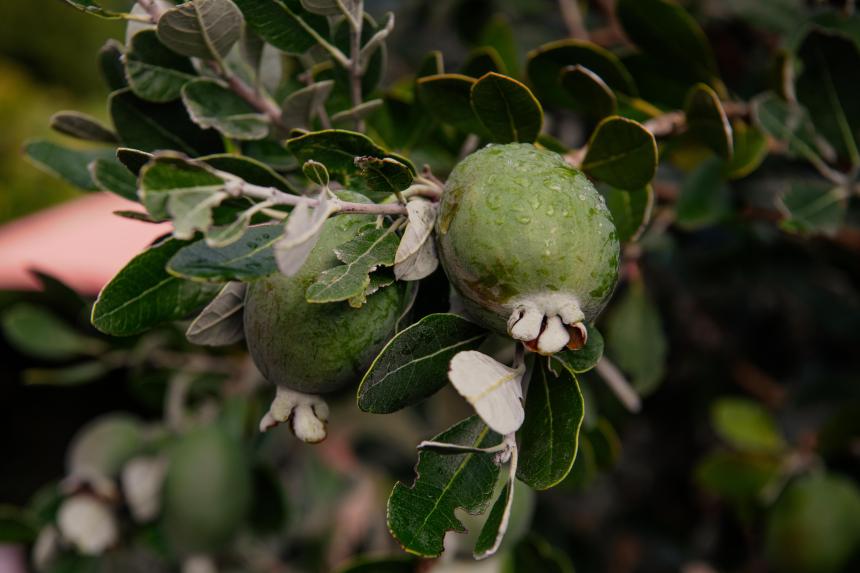RAGLAN, New Zealand – Autumn in New Zealand heralds the arrival of a green, egg-size fruit that falls off trees in such abundance that it is often given to neighbours and colleagues by the bucket or even the wheelbarrow load.
Only in cases of extreme desperation do people buy any.
The fresh fruit, whose flesh is gritty, jelly-like and cream-coloured, is used in muffins, cakes, jams and smoothies, and it begins appearing on high-end menus each March – the start of autumn in the Southern Hemisphere.
Off-season, it is found in food and drink as varied as juices and wine, yogurt and kombucha, and chocolate and popcorn.
This ubiquitous fruit is the feijoa (pronounced fee-jo-ah). Known in the United States as the pineapple guava, it was first brought to New Zealand from South America via France and California in the early 1900s.
Its tangy taste is hard to describe, even for die-hard fans. But what is easy to pinpoint is that, like the kiwi fruit, which originated in China, and the kiwi, a native bird, the feijoa has become for many here a quintessential symbol of New Zealand, or Aotearoa, as the country is known in the indigenous Maori language.

“Even though it isn’t from Aotearoa, it’s definitely something that I associate with the Aotearoa modern pataka, the modern food pantry,” said chef Monique Fiso, who has Maori and Samoan ancestry and has worked in top New York restaurants for more than five years.
Now back in New Zealand, she is a pioneer of modern Polynesian cuisine and often serves feijoas to her customers.
“It’s certainly one of my favourite fruits to work with, especially when we’re making sorbets, because it’s so refreshing,” she said. “Feijoas have a lot of versatility – you can bake with them, you can make ice cream with them, you can make jam with them. And they have a place with savoury as well.”
Not every New Zealander loves feijoas, she cautioned. Sometimes customers will specify “just no feijoa” when they make reservations. It is a sentiment she cannot understand. “I find that a bit crazy,” she said. “I’m, like, what’s your issue? They’re the greatest fruits ever.”
For fans, nothing can quite match the autumnal experience of eating an entire bucket of the freshly fallen fruit.
“You can cut it in half and eat it with a spoon, or you can just bite it open with your teeth and suck the contents out,” David Farrier, a New Zealand film-maker and journalist who lives in Los Angeles, said somewhat wistfully.

He has often tried to explain feijoas to mystified Americans. “I say it’s about the size of an egg – just imagine a green chicken egg with a little hat on top,” he said. “The flavour? Honestly, it tastes like feijoa. And if you haven’t had a feijoa, then you’re missing out.”
People have compared feijoas to guavas – a distant relative – and to a mixture of pineapple and strawberry.
Feijoas originated in Uruguay, the southern highlands of Brazil and a corner of northern Argentina. But they thrive across most of New Zealand, growing easily with little care and facing few pests, and they quickly found their way into local diets.

Mr Rohan Bicknell, an Australian who imports and exports fruits and vegetables, has a front-row seat to the feijoa mania.
He accidentally discovered feijoas in 2013, when a shortage of passion fruit in his home country forced him to order some from New Zealand. The suppliers threw in a few hundred kilograms of feijoas as well.
Mr Bicknell thought they were delicious, and they sold out in a week, snapped up by homesick New Zealand expatriates.
He now has 32 feijoa trees growing in his Brisbane backyard, a 1,000-tree feijoa orchard in the south Queensland highlands, and an online store called Feijoa Addiction that caters mostly to the many New Zealanders living in Australia.
People of few other countries have quite the same level of feeling for a fruit, he said. “Malaysians and durians and Kiwis and feijoas are probably on the same strength of addiction,” he said. “Maybe Indians and mangoes.”
Australians are fond of mulberries, “but the connection is nowhere near as strong as between a feijoa and a person from New Zealand”. NYTIMES

